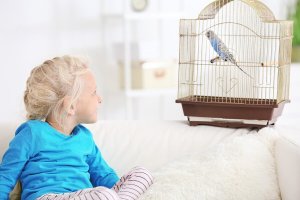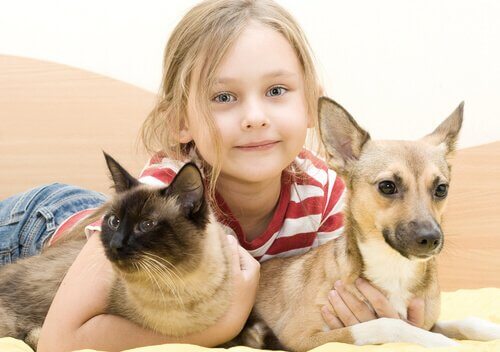Advantages of Children Having a Pet


Reviewed and approved by the psychologist María Alejandra Castro Arbeláez
People often talk about the many advantages of children having a pet. Indeed, if you want your children to learn about the value of life and responsibilities, as well as strengthen their immune, respiratory and circulatory systems, it’s great to give your child a friendly pet.
Pets can fill your home with love, laughter and joy. Animals like dogs can be important guardians and companions for children. Knowing the advantages of children having a pet can inspire you to expand your family.
Humans’ interest in animals
Humans, regardless of their age, have always felt the need to be close to animals and share with them. It’s not surprising that, around the world, about 40% of the population has pets. They include dogs, cats, birds, and more.
Many households already have a pet before the baby arrives, and get used to living with a baby very easily.
In fact, when this happens, children immediately become familiar with animals from a young age. As a result, they grow up with respect, solidarity, and sensitivity towards all living beings.
Although it’s clear to many people that pets offer emotional and psychological benefits for children, they often think that pets make their children less healthy and affect their wellbeing.
However, except for kids with animal allergies, having a pet can also help the body function better, like the respiratory system.

Advantages of children having a pet
1. Protection against respiratory diseases
Studies show that children who have regular contact with dogs develop fewer respiratory diseases, including allergies.
This happens because the microorganisms on dogs’ skin and fur create an immune response when children breathe them in. This way, they protect the child against certain pathogens.
To be precise, 35% of children who live with dogs have fewer diseases like coughs or rhinitis.
2. Resistance to diseases like earache and fever
The same study from the previous section states that children who share their home with a dog have fewer ear infections: cases are reduced by 50%.
With respect to newborns and babies under 1 year old, their immune systems are better than babies who don’t have a pet. Therefore, they use less antibiotics.
“It’s not surprising that, around the world, about 40% of the population has pets. They include dogs, cats, birds, and more.”
3. Kids learn responsibilities
Children with pets tend to be more ready to do their homework and chores. This is because they learn to take responsibility for the life of another being. In addition, they learn the negative consequences that not doing them can bring.
Some of the responsibilities include: bathing, walking, feeding and teaching them to follow commands and do tricks. Depending on their age, kids can do lots of these tasks.
4. Children are encouraged to get active
Children with dogs are more physically active and more likely to spend time outdoors. Without a doubt, one of the best activities for kids is to run in the park or open fields. Dogs are the best companion for these adventures.
5. Pets also care for and protect children
Animals immediately identify the weakest members of the family and who the children are at home. There are countless stories about dogs that have alerted their owners when a child is in trouble. Also, some have even rescued children in situations of serious danger.
In several colleges and institutions worldwide, friendly dogs like golden retrievers are assigned to make rounds in students’ classrooms. Thus, they serve as both companions and protectors.
Finally, it’s important to note that, when it comes to having pets, adults will have the greatest responsibility to care for them.
However, with the parent’s direction and good training, children will be able to have a companion for games and adventures. Your pet will certainly be a great addition to your home for a long time.
All cited sources were thoroughly reviewed by our team to ensure their quality, reliability, currency, and validity. The bibliography of this article was considered reliable and of academic or scientific accuracy.
- Gómez G., L. F., Atehortua H., C. G., & Orozco Padilla, S. C. (2007). La influencia de las mascotas en la vida humana. Revista Colombiana de Ciencias Pecuarias, ISSN-e 0120-0690, Vol. 20, No. 3, 2007, Págs. 377-386.
- González Jiménez, A., Márquez Hernández, V., López Rodríguez M. (2015). Educación y salud en una sociedad globalizada. Edition: 1ª, Chapter: 39. Universidad de Almería. Pp.186-192. Extraído de: https://books.google.es/books?hl=es&lr=&id=VjwwBwAAQBAJ&oi=fnd&pg=PA186&dq=amistad+mascotas+y+niños&ots=gZSP8yTJVE&sig=wQCtniVtSde2BjvJE-1BaibDLEA#v=onepage&q=amistad%20mascotas%20y%20niños&f=false
- Martínez, C. A. C., Garaviño, S. M. H., Martínez, D. I. J., & Restrepo, M. T. (2011). Estudio descriptivo de los efectos que ejerce el perro como mascota en el desarrollo de la motricidad gruesa de infantes sanos de cinco años de edad. Revista Lasallista de Investigacion.
- Taxa, J. (2012). Representaciones y vínculo entre niños y sus mascotas (MasterThesis). Pontificia Universidad Católica de Perú. Lima. Extraído de: http://tesis.pucp.edu.pe/repositorio/bitstream/handle/123456789/1701/TAXA_MARCOS_JUAN_CARLOS_REPRESENTACIONES.pdf?sequence=1&isAllowed=y
This text is provided for informational purposes only and does not replace consultation with a professional. If in doubt, consult your specialist.








